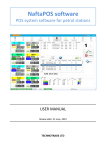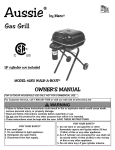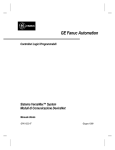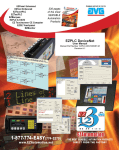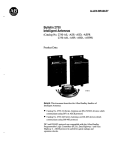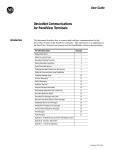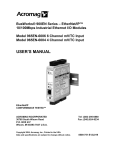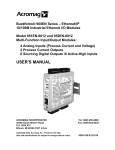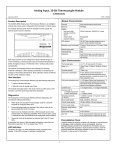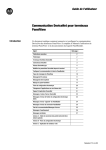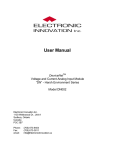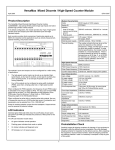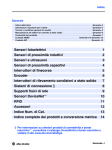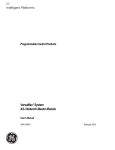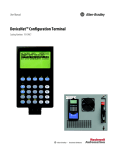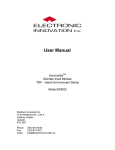Download VersaMax DeviceNet
Transcript
GE Fanuc Automation Programmable Control Products VersaMax™ System DeviceNet Communications Modules User's Manual GFK-1533 June 1999 GFL-002 Warnings, Cautions, and Notes as Used in this Publication Warning Warning notices are used in this publication to emphasize that hazardous voltages, currents, temperatures, or other conditions that could cause personal injury exist in this equipment or may be associated with its use. In situations where inattention could cause either personal injury or damage to equipment, a Warning notice is used. Caution Caution notices are used where equipment might be damaged if care is not taken. Note Notes merely call attention to information that is especially significant to understanding and operating the equipment. This document is based on information available at the time of its publication. While efforts have been made to be accurate, the information contained herein does not purport to cover all details or variations in hardware or software, nor to provide for every possible contingency in connection with installation, operation, or maintenance. Features may be described herein which are not present in all hardware and software systems. GE Fanuc Automation assumes no obligation of notice to holders of this document with respect to changes subsequently made. GE Fanuc Automation makes no representation or warranty, expressed, implied, or statutory with respect to, and assumes no responsibility for the accuracy, completeness, sufficiency, or usefulness of the information contained herein. No warranties of merchantability or fitness for purpose shall apply. The following are trademarks of GE Fanuc Automation North America, Inc. Alarm Master CIMPLICITY CIMPLICITY 90–ADS CIMSTAR Field Control GEnet Genius Helpmate Logicmaster Modelmaster Motion Mate PowerMotion PowerTRAC ProLoop PROMACRO Series Five Series 90 Series One Series Six Series Three VersaMax VersaPro VuMaster Workmaster ©Copyright 1999 GE Fanuc Automation North America, Inc. All Rights Reserved. Contents Chapter 1 Introduction................................................................................... 1-1 DeviceNet ................................................................................................ 1-2 VersaMax Modules for DeviceNet Networks............................................ 1-3 Chapter 2 Installation..................................................................................... 2-1 Preinstallation Check................................................................................ 2-1 DeviceNet Network Interface Unit Installation ......................................... 2-2 DeviceNet Network Control Module Installation ...................................... 2-5 Installing the DeviceNet Cable ................................................................. 2-8 Bus Connectors and Termination.............................................................2-10 Bus Power Supply and Grounding...........................................................2-11 Chapter 3 The DeviceNet Network Interface Unit ........................................ 3-1 NIU Specifications ................................................................................... 3-2 Autoconfiguration .................................................................................... 3-3 EDS File .................................................................................................. 3-5 Network Interface Unit Operation............................................................. 3-6 Network Interface Unit Status/Control Data Formats ................................ 3-8 Chapter 4 The DeviceNet Network Control Module ..................................... 4-1 NCM Specifications ................................................................................. 4-2 The Communications Carrier.................................................................... 4-3 Configuring the Network Control Module ................................................ 4-4 Operation of the NCM.............................................................................. 4-9 Fault Handling ........................................................................................4-12 Appendix A NIU DeviceNet Statement of Compliance.................................... A-1 Appendix B NCM DeviceNet Statement of Compliance ................................. B-1 Appendix C Electronic Datasheet (EDS) for the NIU Module ........................ C-1 Appendix D Electronic Datasheet (EDS) for the NCM Module...................... D-1 GFK-1533 iii Chapter Introduction 1 This manual describes the installation and operation of the VersaMax™ DeviceNet Communications modules. Chapter 1 is a basic introduction. Module and cable Installation procedures are described in Chapter 2. The DeviceNet Network Interface Unit is described in chapter 3. This chapter explains how the NIU is configured and how it operates. The DeviceNet Network Control Module is described in chapter 4. This chapter explains how the NCM is configured and how it operates. The NIU Statement of Compliance is shown in appendix A. The NCM Statement of Compliance is shown in appendix B. The NIU Electronic Datasheet (EDS) File is detailed in appendix C. The NCM EDS File is detailed in appendix D. Other VersaMax Manuals GFK-1533 VersaMax Modules, Power Supplies, and Carriers User’s Manual (catalog number GFK-1504) Describes the many VersaMax I/O and option modules, power supplies, and carriers. This manual also provides detailed system installation instructions. VersaMax Profibus Communications Modules User’s Manual (catalog number GFK-1534) Describes the installation and operation of the Profibus communications modules. VersaMax Genius NIU User’s Manual (catalog number GFK-1535) VersaMax PLC User’s Manual (catalog number GFK-1503) Describes the installation and operation of the Genius NIU. Describes the installation and operation of the VersaMax CPU. 1-1 1 DeviceNet DeviceNet supports a variety of communication structures including peer to peer, multimaster and master/slave with broadcasting capabilities. This allows DeviceNet to fill a broad range of control system needs. Up to 64 nodes can be connected to a DeviceNet network without bridging or routing. Nodes can range from single-bit devices, such as a limit switch or solenoid valve, to intelligent I/O stations with several I/O modules. The maximum amount of I/O data that can be transferred from or to an individual node is theoretically not limited. Practical limitations should be based on the response time requirements of the application. DeviceNet Messages The DeviceNet message field can range between 0 and 8 bytes. Messages longer than 8 bytes are fragmented into packets. Packetizing does increase overhead and reduce data transmission throughput. DeviceNet supports two types of messaging: I/O messaging and Explicit messaging. I/O messaging is time-critical and is of high priority. Explicit messages are typically used between two devices for configuration and diagnostic data transfer. They are usually of low priority and not time-critical. DeviceNet I/O messages are of three basic types. Strobe messages are associated with a polling request from a master. Strobe messages can be used for communication between two devices or where there are several consumers of a single message. Cyclical messaging transfers data between devices at regular time intervals. Devices may use cyclical messages to report their status to a master at regular time intervals. The third type of I/O messaging is unsolicited messaging from slave devices, commonly referred to as change-of-state messaging. This type of I/O message allows I/O to report information without token passing or polling. Repetitive information is transmitted less frequently, which frees up the available bandwidth. This type of messaging offers more responsive control when network traffic is light. However, it can be more difficult to make sure that data collisions do not reduce network throughput. Additional Information about DeviceNet For detailed information about DeviceNet, please contact the Open DeviceNet Vendor Association at the address below. Open DeviceNet Vendor Association, Inc. 20423 State Road 7 Suite 499 Boca Raton, FL. 33498 phone: (954) 340-5412 FAX: (954) 340-5413 Internet: HTTP://WWW.ODVA.ORG Email: <[email protected]> 1-2 VersaMax™ System DeviceNet Communications Modules User's Manual – June 1999 GFK-1533 1 VersaMax Modules for DeviceNet Networks There are two different VersaMax modules for DeviceNet networks: the DeviceNet Network Interface Unit (NIU), and the DeviceNet Network Control Module (NCM). DeviceNet Network Interface Unit The DeviceNet Network Interface Unit (IC200DBI001) is a DeviceNet slave module that acts as controller for an I/O Station of VersaMax modules. I/O modules in the station operate with their default characteristics (described in the VersaMax Modules, Power Supplies, and Carriers Manual, GFK-1504). Many types of modules can be combined to suit the needs of the application. Power for module operation is provided by a power supply that installs directly on the NIU. Additional “booster” power supplies can be included in the system if needed for modules with high current requirements. DeviceNet NIU power supply Optional booster power supply DeviceNet Network Control Module The DeviceNet Network Control Module (IC200BEM103) is a communications module that can be configured to operate as a master, as a slave, or as both simultaneously. It can exchange up to 512 bytes of input data and 512 bytes of output data with other devices on the DeviceNet network. The VersaMax PLC CPU can read and write this data as though it were conventional bit- and word-type I/O data. The Network Control Module installs on a VersaMax Communications Carrier. Power for the NCM comes from the power supply on the CPU or from a booster supply as shown below. VersaMax PLC CPU power supply GFK-1533 Chapter 1 Introduction Optional booster power supply DeviceNet Network Control Module 1-3 Installation Chapter 2 This section gives instructions for installing the DeviceNet modules and the DeviceNet cable. System installation instructions are located in the VersaMax Modules, Power Supplies, and Carriers Manual, GFK-1504. • DeviceNet Network Interface Unit Installation • DeviceNet Network Control Module Installation • DeviceNet Cable Installation Preinstallation Check Carefully inspect all shipping containers for damage. If any equipment is damaged, notify the delivery service immediately. Save the damaged shipping container for inspection by the delivery service. After unpacking the equipment, record all serial numbers. Save the shipping containers and packing material in case it is necessary to transport or ship any part of the system. Static Protection The Network Interface Unit has CMOS components that are susceptible to static damage. Use proper static prevention techniques when handling this module. Conformance to Standards Before installing VersaMax products in situations where compliance to standards or directives from the Federal Communications Commission, the Canadian Department of Communications, or the European Union is necessary please refer to GE Fanuc’s Installation Requirements for Conformance to Standards, GFK-1179. GFK-1533 2-1 2 DeviceNet Network Interface Unit Installation The NIU snaps directly onto the DIN rail. No tools are required. Removing the NIU from the DIN Rail 1. 2. 3. 4. Turn off power to the power supply. (If the NIU is attached to the panel with a screw) remove the power supply module. Remove the panel-mount screw. Slide the NIU along the DIN rail away from the other modules until the connector disengages. With a small flathead screwdriver, pull the DIN rail latch tab outward while tilting the other end of the module down to disengage it from the DIN rail. Installing the Power Supply on the NIU 1. The power supply module installs directly on top of the NIU. The latch on the power supply must be in the unlocked position. 2. Align the connectors and the latch post and press the power supply down firmly, until the two tabs on the bottom of the power supply click into place. Be sure the tabs are fully inserted in the holes in bottom edge of the NIU. Turn the latch to the locked position to secure the power supply to the top of the NIU module. 3. Removing the Power Supply from the NIU Exercise care when working around operating equipment. Devices may become very hot and could cause injury. 2-2 1. Remove power. 2. Turn the latch to the unlocked position as illustrated. 3. Press the flexible panel on the lower edge of the power supply to disengage the tabs on the power supply from the holes in the carrier. 4. Pull the power supply straight off. VersaMax™ System DeviceNet Communications Modules User's Manual – June 1999 GFK-1533 2 Network Interface Unit Installation: Setting the Network Address Open the clear protective door by pulling upward at the indentation in the side of the NIU. Use a 2.44mm (3/32in) flat screwdriver to adjust the rotary switches. These switches, marked Node Address X10 and X1 select the tens and units digits of the network address. Select any valid address in the range 0-63. U: Power up in upload mode U 0 1 2 3 6 5 4 9 0 1 2 8 3 7 6 5 4 0 1 2 NODE ADDRESS X10 X1 DATA RATE Setting the Data Rate Use the switch marked Data Rate to select the network data rate: 0 = 125K 1 = 250K 2 = 500K Upgrading the NIU Firmware 1. Connect the cable (IC200CBL002) from the programming device to the port on the lefthand side of the NIU. 2. Set the upper switch (x10) to the U (Upload) position. 3. Cycle power to the NIU. When the NIU is in boot mode, its OK and FAULT LEDs blink simultaneously at ½ second intervals. Once the NIU is in boot mode, the upper switch can be returned to its original position. GFK-1533 Chapter 2 Installation 2-3 2 Network Interface Unit Installation: Observing the LEDs The LEDs indicate the presence of power and show the operating mode and status of the NIU. PWR OK FAULTS PWR green when power is applied to the NIU. OK green when the NIU is operational. FAULTS amber if the NIU has detected one or more faults. MOD OFF when the NIU is not powered. MOD blinks red and green during NIU self-test. NET FORCE blinks green if the NIU configuration is missing, incomplete, or incorrect. The NIU may be in Standby state. green when the NIU is operating normally. blinks red if there is a recoverable fault. red if there is an unrecoverable fault. The NIU may need replacing. NET OFF when the NIU is not online or not powered. blinks red and green if the NIU detects a Network Access error and is in the Communications Faulted state. It has subsequently received and accepted an Identify Communications Fault Request-Long Protocol message. blinks green if the NIU is online but has no connections in the established state. It is online but has no established connections to other nodes. It is not allocated to a master. green when the NIU us inline and has connections in the established state. The NIU is allocated to a master. blinks red if one or more I/O Connections are in the Timed-Out state. red if an error renders the NIU incapable of communicating on the network. FORCE 2-4 (future) indicates the presence of any forced I/O value. Always OFF. VersaMax™ System DeviceNet Communications Modules User's Manual – June 1999 GFK-1533 2 DeviceNet Network Control Module Installation The DeviceNet Network Control Module mounts on a Communications Carrier (IC200CHS006), which is installed on the DIN rail as described in the VersaMax Modules, Power Supplies and Carriers Manual (GFK-1504). The Communications Carrier snaps easily onto the DIN rail. No tools are required for mounting or grounding to the rail. Removing the Communications Carrier from the DIN Rail GFK-1533 1. Turn off power to the power supply. 2. (If the Communications Carrier is attached to the panel with a screw) remove the Network Control Module. Remove the panel-mount screw. 3. Slide the carrier along the DIN rail away from the other modules until the connector disengages. 4. With a small flathead screwdriver, pull the DIN rail latch tab outward while tilting the other end of the module down to disengage it from the DIN rail. Chapter 2 Installation 2-5 2 Network Control Module Installation: Installing the NCM on the Communications Carrier 1. The latch on the Network Control Module must be in the unlocked position. 2. Align the connectors and the latch post and press the Network Control Module down firmly, until the two tabs on the bottom of the NCM click into place. Be sure the tabs are fully inserted in the holes in bottom edge of the Communications Carrier. 3. Turn the latch to the locked position to secure the Network Control Module to the top of the carrier. Removing the Network Control Module from the Carrier Exercise care when working around operating equipment. Devices may become very hot and could cause injury. 2-6 1. Remove power. 2. Turn the latch to the unlocked position as illustrated. 3. Press the flexible panel on the lower edge of the NCM to disengage the tabs on the NCM from the holes in the carrier. 4. Pull the NCM straight off. VersaMax™ System DeviceNet Communications Modules User's Manual – June 1999 GFK-1533 2 Network Control Module Installation: Observing the LEDs OK OK MOD OFF when the NCM has not yet started its powerup sequence. Blinking green indicates the NCM is performing its powerup sequence and has not yet finished successfully. NET Green indicates the NCM has successfully completed powerup diagnostics. Amber when the NCM has either failed powerup diagnostics or has not yet received a valid configuration from the CPU. Blinking amber means the NCM has failed powerup diagnostics. The number of blinks indicates the fault type. MOD OFF when the NCM is not powered. blinks green if the NCM configuration is missing, incomplete, or incorrect. The NCM may be in Standby state. green when the NCM is operating normally. blinks red if there is a recoverable fault. red if there is an unrecoverable fault. The NCM may need replacing. blinks red and green during NCM self-test. NET OFF when the NCM is not online or not powered. blinks red and green if the NCM detects a Network Access error and is in the Communications Faulted state. blinks green if the NCM is online but has no connections in the established state. It has no established connections to other nodes. green when the NCM us inline and has connections in the established state. blinks red if one or more I/O Connections are in the TimedOut state. red if an error renders the NCM incapable of communicating on the network. GFK-1533 Chapter 2 Installation 2-7 2 Installing the DeviceNet Cable A DeviceNet network uses 5-wire, multi-conductor copper cable. Two wires form a twisted pair transmission line for network communications. A second pair transmits network power. The fifth conductor forms an electromagnetic shield. Cabling is available in a variety of current-carrying capacities. On a DeviceNet fieldbus, every device must, at least, power its network transceivers from the network power source. Some devices draw all of their power from the network supply. A network can include both high-capacity trunk cable and lower-capacity cable for individual branch circuits. DeviceNet specifies two types of network cable, Thick and Thin cable. Thick cable provides for longer distances and more power. Generally, Thick cable is used for the Trunk cable. Thin cable is used for shorted distances and is generally used for drop cables or where cable flexibility is necessary. DeviceNet Cable Specifications Thick Cable General Specifications Two shielded pairs - Common axis with drain wire in center Overall braid shield - 65% coverage; 36 AWG or 0.12mm tinned Cu braid minimum (individually tinned) Drain wire- #18 Copper min.; 19 strands minimum (individually tinned) Outside diameter - 0.410 inches (min) to 0.490 inches (max.) roundness -radius delta to be within 15% of 0.5 O.D. Thin Cable General Specifications Two shielded pairs - Common axis with drain wire in center Overall braid shield - 65% coverage; 36 AWG or 0.12mm tinned Cu braid minimum (individually tinned) Drain wire - #22 Copper; 19 strands minimum (individually tinned) Outside diameter - 0.240 inches (min.) to 0.280 inches (max.) roundness -radius delta to be within 20% of 0.5 O.D. 2-8 Network Topology Bus with limited branching (trunkline/dropline) Redundancy Not Supported Network Power for Node devices Nominal 24 volt DC ±4% Allowed Nodes (Bridging excluded) 64 nodes Data Packet Size 0-8 bytes with allowance for message fragmentation Duplicate Address Detection Addresses verified at power-up Error Detection / Correction CRC - retransmission of message if validity not acknowledged by recipient VersaMax™ System DeviceNet Communications Modules User's Manual – June 1999 GFK-1533 2 Bus Length The maximum length of the bus is limited by the cable type, transfer rate, and number and accumulated length of drop lines. Individual branch lengths may not exceed 6 meters and are limited to one network node per drop. However, the node may be a node offering multiple ports. With Thin cable, the maximum bus length, regardless of data rate, is 100m. With Thick cable used as the trunk line, the maximum bus length is as shown in the following table. GFK-1533 Data Rate Bus length and drop length restrictions 500Kbps 100m bus length and branches totaling < 39m 250Kbps 250m bus length and branches totaling < 78m 125Kbps 500m bus length and branches totaling < 156m Chapter 2 Installation 2-9 2 Bus Connectors and Termination DeviceNet has two basic connection types. An open connector is available with inline terminal block wiring terminations. This connection type is suitable for environments without excessive humidity or vibration levels. The second type uses a five-pole, circularly-arranged connector. This type provides a robust connection is more resistant to moisture and vibration. Bus Connectors The NIU and NCM both have the same 5-pin standard Phoenix open-style pluggable connector, although in different orientations. The illustration below shows the connector orientation on both modules: Network Interface Unit (NIU) Network Communications Module (NCM) 5 - V+ 4 - CAN_H 1 - V2 - CAN_L 3 - Shield 3 - Shield 2 - CAN_L 4 - CAN_H 1 - V- 5 - V+ The connectors are keyed, so that a mating connector may attach to either module without modification. Connector Pin Assignments The pin to signal to wire color assignments are shown in the following table: Pin Signal Wire Color 1 V- Black 2 CAN_L Blue 3 Shield Bare 4 CAN_H White 5 V+ Red Termination Termination of a DeviceNet network is passive and includes one resistor at each end of the network, i.e. exactly two resistors per DeviceNet network. A terminating resistor is placed across the data communication signals at pin 2 (CAN_L) and pin 4 (CAN_H). The correct terminating resistor is a 121 ohm 1% ¼ watt resistor. 2-10 VersaMax™ System DeviceNet Communications Modules User's Manual – June 1999 GFK-1533 2 Bus Power Supply and Grounding DeviceNet requires a power supply of 24VDC (±4%) at a 16A maximum. However, with the use of Thick cable, a maximum of 8A is permitted on a single network segment. This is possible if the power supply is placed at the center point of two network segments, thus supplying 8A to each segment. With the use of Thin cable, a maximum of 3A is permitted. As with most Fieldbus networks, grounding of the network and its devices is very important. In DeviceNet, it is required that all cable shields be tied to ground at each device connection. This is done by tying the bare wire of the cable to pin 3 (Shield) of the connector. The DeviceNet network power supply must also be grounded, but only at one point. The V- signal must be connected to Protective Earth Ground at the power supply only. If multiple power supplies are used, only one power supply must have V- connected to Earth Ground. GFK-1533 Chapter 2 Installation 2-11 Chapter The DeviceNet Network Interface Unit 3 The DeviceNet Network Interface Unit (IC200DBI001) can be used to interface VersaMax I/O modules to a DeviceNet network. Together, the NIU and its modules form an I/O station capable of handling up to 128 bytes of discrete and analog input data and up to 128 bytes of discrete and analog output data. The system host can be any device capable of operating as a bus master. The NIU operates as a Group 2 Only Slave, automatically exchanging I/O, status, control, and diagnostic data with a master device. The NIU conforms to the DeviceNet Specification Volumes I and II, version 2.0, Open DeviceNet Vendors Association. DBI001 PWR OK FAULT MOD MOD MOD NET FORCE MOD IC200DBI001-AA DeviceNet NIU U 0 1 NODE ADDRESS X10 2 3 5 4 9 0 1 2 8 3 7 6 5 4 6 X1 9 012 DATA RATE V+ CAN_H SHLD THIS DEVICE COMPLIES WITH PART 15 OF THE FCC RULES. OPERATION IS SUBJECT TO THE FOLLOWING CONDITIONS: 1) THIS DEVICE MAY NOT CAUSE HARMFUL INTERFERENCE. 2) THIS DEVICE MUST ACCEPT ANY INTERFERENCE RECEIVED, INCLUDING INTERFERENCE THAT MAY CAUSE UNDESIRED OPERATION. THIS DIGITAL APPARATUS DOES NOT EXCEED THE CLASS A LIMITS FOR RADIO NOISE EMISSIONS FROM DIGITAL APPARATUS SET OUT IN THE RADIO INTERFERENCE REGULATIONS OF THE CANADIAN DEPARTMENT OF COMMUNICATIONS. FOR USE IN A CONTROLLED ENVIRONMENT. REFER TO MANUALS FOR ENVIRONMENTAL CONDITIONS. ENCAD D'UTILISATION EN ATMOSPHERE CONTROLEE. CONSULTER LA NOTICE TECHNIQUE. IND CONT EQ FOR HAZ LOC CLASS I DIV 2 GROUPS ABCD Temp Code T4A Ambient 60C CLASS I ZONE 2 GROUP IIC T4A CLASS I ZONE 2 Ex nA IIC T4A 0C Ta 60C Ex nV II T4 Demko No MADE IN USA CAN_L V- The Network Interface Unit installs on a 35mm x 7.5mm conductive DIN rail. A VersaMax power supply module mounts directly on the righthand side of the NIU. LEDs on the lefthand side indicate the presence of power and show the operating mode and status of the NIU. Three rotary dials beneath a clear protective door are used to configure the NIU’s address and data rate on the DeviceNet network. The connector is used to connect the bus cable. GFK-1533 3-1 3 NIU Specifications Number of VersaMax modules 8 I/O Modules per station. I/O data Up to 128 bytes of inputs + 2-byte status word Up to 128 bytes of outputs + 2-byte control word. DeviceNet network address 0 to 63. Default is 63. DeviceNet network data rate 125K, 250K, 500K baud 3-2 Indicators (6) Power LED to indicate presence or absence of power. OK LED to indicate the status of the NIU powerup. Fault LED to indicate presence of faults. Mod LED to indicate the status of the NIU module. Net LED to indicate health of the DeviceNet network. Force LED (not used) . Power Consumption 160mA at 5V, 10mA at 3.3V Communication Structure Master/Slave Media Access Arbitration CSMA with non-destructive bit-wise arbitration VersaMax™ System DeviceNet Communications Modules User's Manual – June 1999 GFK-1533 3 Autoconfiguration The NIU stores data internally as discrete input bits, discrete output bits, analog input words, and analog output words. The NIU Data Memories I discrete input bits AI analog input words Q discrete output bits AQ analog output words At powerup the NIU automatically looks at the modules installed in the I/O Station and assigns them to addresses in this internal I/O map. For modules with multiple data types, each data type is assigned individually. The process of assigning addresses is referred to as autoconfiguration. Autoconfiguration Sequence Autoconfiguration assigns memory addresses by data type, in the same order the modules occupy in the I/O Station. Each module is considered to occupy a “slot”. The position adjacent to the NIU is slot #1. Booster power supplies do not count as occupying slots. 1 2 3 4 5 Autoconfiguration stops at the first empty slot or faulted module. For example, if there are modules in slots 1, 2, 3, and 5 but slot 4 is empty, the module in slot 5 is not autoconfigured. The NIU generates an Extra I/O Module fault for it. GFK-1533 Chapter 3 The DeviceNet Network Interface Unit 3-3 3 Autoconfiguring the DeviceNet NIU When the NIU is powered up for the very first time, it autoconfigures all the I/O modules that are connected to it. All I/O modules physically installed in the I/O Station are included in the new configuration provided no intervening empty carriers exist. For the autoconfiguration process to work as expected, any additional power supplies in the I/O Station must be powered up at exactly the same time or before the main power supply. The NIU retains this configuration until it is either cleared or powered up with I/O modules added to the existing configuration. Adding I/O modules to an Already Configured NIU If additional I/O modules are added to an existing NIU, they do not become part of the DeviceNet network configuration until the NIU is power-cycled. Hot Inserting I/O Modules It is possible to hot insert I/O modules into the I/O Station. When replacing a module that already exists in the configuration, no other action is necessary to make the module operable. Clearing the Configuration To clear an existing configuration from the NIU, power down the NIU, disconnect the NIU from the first I/O module, and power up the NIU. The configuration in the NIU is then cleared. 3-4 VersaMax™ System DeviceNet Communications Modules User's Manual – June 1999 GFK-1533 3 EDS File Every DeviceNet device certified by the Open DeviceNet Vendors Association is required to define an EDS file (electronic data sheet). The EDS file may be needed by DeviceNet network configuration tools to correctly configure and/or operate a DeviceNet device. The EDS file is a simple text file filled with keywords and values that together define the specific characteristics, features, and limitations of the slave device. In Appendix C is a printout of the initial version of the EDS file for the VersaMax DeviceNet Network Interface Unit. In Appendix D is a printout of the initial version of the EDS file for the VersaMax Network Control Module. They are included only for reference; an electronic version of the EDS file is included on a diskette with each VersaMax DeviceNet device. GFK-1533 Chapter 3 The DeviceNet Network Interface Unit 3-5 3 Network Interface Unit Operation The NIU exposes exactly one input data object to read from the NIU and one output data object to write to the NIU. These data objects and what they contain are described here. Input Data Sent by the NIU to the Master The NIU sends one input message containing the data from all of the discrete input (I) and analog input (AI) areas configured in the NIU’s network I/O map. Within the discrete and analog data areas, the data is sent in the same sequence the modules physically occupy in the I/O Station. For example, if the first I/O module provides discrete input data, that data will appear first in the Discrete Input Data area. If the second module also provides discrete input data, that data will appear next, and so on. The same rule applies for the Analog Input Data area. If a single module provides both discrete and analog input data, its discrete data is placed in the discrete area and the analog data in the analog area. The maximum overall length of input data is 128 bytes. An additional 2 bytes at the start of the message are used by the NIU for status data to the master application. So the total maximum length of the input message from the NIU is 130 bytes. Õ To Master 3-6 First byte Status 2 bytes Input Data Message Discrete Input Data Last byte Analog Input Data Maximum Input Data Length = 128 bytes Maximum Total Length = 130 bytes VersaMax™ System DeviceNet Communications Modules User's Manual – June 1999 GFK-1533 3 Output Data Sent by the Master to the NIU The master sends the NIU one output message containing all of the output data for the configured discrete output (Q) and analog output (AQ) areas configured in the NIU’s network I/O map. The data must be placed in the same sequence the modules physically occupy in the I/O Station. For example, if the first I/O module provides discrete output data, that data will appear first in the Discrete Output Data area. If the second module also provides discrete output data, that data will appear next, and so on. The same rule applies for the Analog Output Data area. If a single module receives both discrete and analog output data, its discrete data is placed in the discrete area and the analog data in the analog area. The maximum overall length of this output data is 128 bytes. An additional 2 bytes at the start of the message are used by the master for control operations. So the total maximum length of the output message from the master is 130 bytes. Õ To NIU First byte Control 2 bytes Output Data Message Discrete Output Data Last byte Analog Output Data Maximum Output Data Length = 128 bytes Maximum Total Length = 130 bytes Output Defaults On powerup, when the bus is broken, or when communications errors occur, all outputs go to their auto-configured default state. Outputs remain at the Output Default State until the module receives output data from the master. Discrete output data defaults to 0 while analog output data holds its last state. GFK-1533 Chapter 3 The DeviceNet Network Interface Unit 3-7 3 Network Interface Unit Status/Control Data Formats The master application is able to access fault information from the NIU’s internal fault table, which can store up to 32 faults. The internal fault table operates as a First-In-FirstOut stack. When fault 33 occurs, fault 1 is dropped from the table. These faults can include both faults provided by the I/O modules and diagnostic information provided by the NIU itself. Reporting Faults The NIU reports faults to the master automatically as part of its regular I/O data. Normally, in the absence of any faults in the NIU, the NIU Diagnostic Status Word is always 0. When the first fault is logged into an empty fault table, the NIU updates the Diagnostic Status Word to indicate both the presence of a fault and the specified information for that fault. The NIU continues to report the fault until either a power-cycle occurs or a DeviceNet master requests to acknowledge the fault or clear all the faults. Acknowledging Individual Faults A DeviceNet master requests to acknowledge a fault in the NIU fault table using the NIU Control Word. When the NIU receives an acknowledge fault request, the NIU updates the content of its Diagnostic Status Word with the Format 2 word for that fault. The master can then acknowledge the Format 2 Word of the fault (also using the NIU Control Word). When the NIU receives this acknowledgement, the NIU updates the Diagnostic Status Word to indicate the Format 1 Word of the next oldest fault in the fault table. This process continues until all of the faults have been reported. If no other faults exist, the NIU clears the Diagnostic Status Word, which indicates that no more faults are present. Clearing All Faults A DeviceNet master can also use the NIU Control Word to request to clear all the faults in the NIU fault table. When the NIU receives a request to clear all faults, it clears the fault table, clears the NIU Diagnostic Status Word, and sends a Clear Fault message to each I/O module present. If any of the original fault conditions in an I/O module still exist after the Clear Faults request, the NIU logs a new fault in its fault table. Resetting the NIU or cycling power also clears the fault table. 3-8 VersaMax™ System DeviceNet Communications Modules User's Manual – June 1999 GFK-1533 3 NIU Status Data Formats The first two bytes of the input data to the master are reserved for the NIU status data. The NIU status data indicates the local status of the NIU and its associated I/O modules. The status is reported in the form of a fault message. Each fault message requires 4 bytes to fully describe the fault. Since there are only 2 bytes of NIU status in the input data to the master, the NIU status defines two data formats. Format 1 indicates the presence of a fault and a fault code that identifies the type of fault. When the Format 1 fault is acknowledged by the master, the NIU transmits Format 2 which indicates the specific location of that fault. When the Format 2 fault is acknowledged by the master, the NIU transmits Format 1 of the next fault in the NIU internal fault table. By continuing to acknowledge each fault, the master can read the entire fault table from the NIU. Status Data Format 1 Byte 1 7 6 5 4 3 2 1 Fault code (0-63) Bit(s) 0-1 Value 0 2-7 0 to 63 Byte 2 Bit(s) 0-6 7 GFK-1533 Value always 0 0 or 1 0 Format (0-3) Meaning Format identifier 0 = Format 1 of NIU Diagnostic Status Data 1 = Format 2 of NIU Diagnostic Status Data 2,3 = Reserved The fault code that identifies the fault. 0 Unknown Fault 11 High Alarm 1 Corrupted Configuration 12 Low Alarm 2 Unsupported Feature 13 Overrange 3 -14 Underrange 4 Config Mismatch 15 Short Circuit 5 Fuse Blown 16 Nonvolatile Store 6 Loss of I/O Module 17 Loss of Non I/O Module 7 Addition of I /O Module 18 Addition of Non I/O Module 8 Extra I/O Module 19 Insufficient Config Memory 9 Loss of User Power 20 Module Not Configured 10 Open Wire -7 6 Fault Reserved (always 0) 5 4 3 2 1 21 22 23 24 25 26 27 28 29 30 Input Point Fault Wiring Fault Thermistor Fault A To D Convertor Fault Mail Queue Full ------- 0 Meaning Reserved (always 0) 0 = no fault data present. The remaining fields in byte 1 and 2 may be ignored. 1= a fault is present. The remaining fields in byte 1 provide the fault code and format identifier. Use the Fault fragment acknowledge command (FRG) bit in the NIU Control bytes to obtain the rack, slot, and point location of the fault. Chapter 3 The DeviceNet Network Interface Unit 3-9 3 Status Data Format 2 Byte 1 7 6 5 4 3 Point (0-63) Bit(s) 0-1 Value 1 2-7 0 to 63 Byte 2 3-10 Value 0-8 0-7 7 0 or 1 1 0 Format (0-3) Meaning Format identifier 0 = Format 1 of NIU Status Data 1 = Format 2 of NIU Status Data 2,3 = Reserved The physical “point” location of the fault. 0-63 correspond to points 1-64. 7 Fault Bit(s) 0-3 4-6 2 6 5 Rack (0-7) 4 3 2 Slot (0-8) 1 0 Meaning The “slot” location of the faulted module. The value 0 indicates the NIU itself. The physical “rack” location of the faulted I/O module. The value 0 refers to the NIU main rack. 0 = no fault data present. The remaining fields in byte 1 and 2 may be ignored. 1 = a fault is present. The remaining fields in byte 1 and 2 provide the format identifier and rack, slot, and point location of the fault. VersaMax™ System DeviceNet Communications Modules User's Manual – June 1999 GFK-1533 3 NIU Control Data Format The first two bytes of the output data from the master are reserved for the NIU control data. The NIU control data defines several bits that can be used by the master application to send commands to the NIU. The following table defines the bits and their meanings. Byte 1 Bit(s) 0 Value 0 or 1 1 0 or 1 2-6 always 0 0 or 1 7 Byte 2 GFK-1533 7 CLR 6 5 4 3 Reserved (always 0) 2 1 FLT 0 FRG Meaning Fault fragment acknowledge command. When this bit changes to 1, the NIU updates the NIU status data to contain either the Format 2 bytes of a fault or the Format 1 bytes of the next fault. When the Format 2 bytes of the last fault in the NIU has been acknowledged, the NIU clears the NIU status data. This bit is used when retrieving faults with the NIU Status service. Fault acknowledge command. When this bit changes to 1, the NIU updates the NIU status data to contain the Format 1 bytes of the next fault. The Format 2 bytes of the fault are skipped. This bit is used when retrieving faults with the Read_DP_Slave_Diagnostics_Information service (see appendix A for more information.) If there is no next fault, the NIU clears the NIU status data. Reserved (always 0) Clear all faults command. Setting this bit to 1 clears the NIU’s internal fault table. The NIU’s FAULT LED goes OFF unless a new fault is immediately logged or an existing fault condition continues to exist. This command can be sent at any time. 7 6 5 4 Reserved (always 0) 3 Chapter 3 The DeviceNet Network Interface Unit 2 1 0 3-11 Chapter The DeviceNet Network Control Module 4 The DeviceNet Network Control Module (IC200BEM103) interfaces a VersaMax PLC CPU to a DeviceNet network. The NCM operates as a Group 2 Only Client (master) and can communicate only with Group 2 Slave devices. It can also operate as a Group 2 Only or a UCMM-capable Server (Slave), or as a master and slave simultaneously. When configured as a master, the NCM provides Unconnected Message Manager Proxy (UCMM) capability on behalf of its Group 2 Only Server slave devices. The UCMM Proxy service allows a commercially available DeviceNet monitor utility to communicate with the Group 2 Only Servers owned by the NCM. Multiple NCMs may be present on the same DeviceNet network. The DeviceNet NCM does not supply the power needs of the network. Another device, usually a standalone power supply, must be used for that purpose. Up to 63 additional devices may also reside on the network with the NCM and the power supply. Of these devices, up to 40 may be slaves controlled by the DeviceNet NCM. OK MOD IC200BEM103 DeviceNet NETWORK MASTER NET IND CONT EQ FOR HAZ LOC CLASS I DIV 2 GROUPS ABCD Temp Code T4A Ambient 60C CLASS I ZONE 2 GROUP IIC T4A CLASS I ZONE 2 Ex nA IIC T4A 0C to 60C Ex nV II T4 Demko No MADE INUSA VCAN_L SHLD CAN_H V+ GFK-1533 4-1 4 NCM Specifications Maximum size of input and output buffers (including NCM status area) 1K bytes Address range of master and slave devices 0-63 Largest number of slave devices when NCM is master. 40 Maximum size of a slave reference type 248 bits of discrete input and output 255 words of analog input and output Maximum time to recover a lost slave device Varies with size of network <10 seconds on a 10 device network Isolation: Network to Frame Ground DeviceNet Network to Backplane: 50 VAC continuous, 500 VAC for 1 minute Indicators Module Status, Network Status, OK Current Drawn from Backplane 140 mA max @ 5 Volts Network Bit Rates 125 Kbps 250 Kbps 500 Kbps 4-2 Maximum Number of Nodes on a DeviceNet network 64 Signaling CAN Standard 2.0B Modulation: Encoding: Baseband NRZ with bit stuffing Power supply 5 Volts +/- 3 Media Coupling DC coupled differential Tx/Rx Absolute maximum voltage range -25 to +18 Volts (CAN_H, CAN_L) Transmission technology Shielded Twisted pair Linear (trunkline/dropline); power and signal on the same network cable VersaMax™ System DeviceNet Communications Modules User's Manual – June 1999 GFK-1533 4 The Communications Carrier The Network Master/Slave Module installs on a mounting base called a Communications Carrier (catalog number IC200CHS006). PP LQ PP LQ IC200CHS006 COMMUNICATIONS CARRIER For applications requiring maximum resistance to mechanical vibration and shock, the carrier must also be panel-mounted. GFK-1533 Chapter 4 The DeviceNet Network Control Module 4-3 4 Configuring the Network Control Module The DeviceNet Network Control Module must be configured in two steps. The first step uses the configuration software to include the module in the PLC configuration. The second step uses the programming software to send a COMREQ containing the network addressing and data lengths to the NCM. VersaMax PLC Configuration for the DeviceNet NCM The NCM is configured as part of the overall VersaMax PLC system configuration. The configuration software is used to specify the following module characteristics: 4-4 A location. The NCM can be placed in any module location in the system. In the selected location, insert a Communication Carrier. On that Carrier, insert a Generic Communications Module. Settings: • Select the Reference Address and Length for an I/O area in each of the 4 reference types: I, AI, Q, and AQ. The length for each must exactly match the total amount of data of that type for all the slave devices controlled by the NCM, including the 64 bits of Communications Status Data provided by the NCM itself. For example, the %I length must equal the total amount of all discrete input data contained in the NCM’s input data area, described later in this chapter. And the %AI length must equal the total amount of all analog input data contained in the NCM's input data area. Conversely, the %Q and %AQ lengths must equal the total amount of all discrete and analog output data, respectively. • Enter the Module ID: FFFF9808. Wiring: can be used to enter tags for the different data points. Power Consumption: can be used to enter the power consumption figures for the DeviceNet NCM. VersaMax™ System DeviceNet Communications Modules User's Manual – June 1999 GFK-1533 4 Sending the Configuration COMREQ from the Application Program The second part of configuring an NCM is to send a single COMREQ from the application program to the NCM. No communications can occur until a valid COMREQ is received by the NCM. The format of this COMREQ is shown on the next page. The configuration COMREQ defines whether the NCM is used as a DeviceNet Master, a DeviceNet Slave, or as both simultaneously. It specifies the network address and data rate of the NCM. It also specifies the network address of each device, the I/O mode, and the lengths of each slave’s data. The sum of the I/O data for each slave device (including the NCM itself if the NCM is a Slave) and the 64 bits of Communications Status Data must exactly equal the length for each reference type entered using the configuration software. Configuring the NCM as a DeviceNet Master Only When configuring the NCM as a DeviceNet Master, the COMREQ must specify: • • • the network address of the Master. the network data rate of the Master. For each subordinate slave: • its network address • its I/O mode • the amount of I/O data of each reference type: I, AI, Q, AQ. Configuring the NCM as a DeviceNet Slave Only When configuring the NCM as a DeviceNet Slave, the COMREQ must specify: • • • • its network address its network data rate its network mode the amount of I/O data of each reference type: I, AI, Q, AQ. Configuring the NCM as a DeviceNet Master and Slave Combined When configuring the NCM as both a DeviceNet Master and Slave, the COMREQ must provide all of the configuration information for both a Master and Slave. Note that in this combined scenario, the network mode of the slave is ignored as the Master configuration requires the slave to be UCMM-capable. • • • • the network address of the Master/Slave. the network data rate of the Master/Slave. For the NCM as a Slave the amount of I/O data of each reference type: I, AI, Q, AQ. For each subordinate slave: its network address • its I/O mode • the amount of I/O data of each reference type: I, AI, Q, AQ. • GFK-1533 Chapter 4 The DeviceNet Network Control Module 4-5 4 Configuration COMREQ Format The command block and the data block of the COMREQ are shown below. COMREQ Command Block Word # Contents 1 Length of the data block in words. (Shown below, number of slaves = length): 0=8 5=23 10=38 15=53 20=68 25=83 30=98 35=113 40=128 1=11 6=26 11=41 16=56 21=71 26=86 31=101 36=116 2=14 7=29 12=44 17=59 22=74 27=89 32=104 37=119 3=17 8=32 13=47 18=62 23=77 28=92 33=107 38=122 4=20 9=35 14=50 19=65 24=80 29=95 34=110 39=125 Always 0 Status Pointer Memory (8 = R, 10 = AI, 12 = AQ) Status Pointer Offset (0 based) Always 0 2 3 4 5-6 The slave devices can be entered in the COMREQ in any order. The NCM checks that the lengths for the four data areas sent in the PLC configuration file match the sum of the lengths sent in the COMREQ. For convenience, the units of length in the configuration of a Generic Communication Module match the units of length defined in the COMREQ. Any bit length field must be entered as a multiple of 8 bits, such as 8, 16, 24, etc. COMREQ Data Block Word # 1 2 3 4 5 6 7-8 9 10 11 12-14 126-128 4-6 Byte # 1-2 3 4 5 6 7 8 9 - 10 11-12 13-16 17 18 19 20 21 22 23 - 28 : : 251 – 256 Contents COMREQ Command Number = 1000H Master Address (0 – 63) Master Baud Rate (0 = 125k, 1 = 250k, 2 = 500k) If NCM is Slave, Length of its I data (in bits, 0 if none) If NCM is Slave, Length of its AI data (in words, 0 if none) If NCM is Slave, Length of its Q data (in bits, 0 if none) If NCM is Slave, Length of its AQ data (in words, 0 if none) Reserved for Master Scan Rate (undocumented) 0 = Scan as fast as possible) NCM Slave communication mode (0 = UCMM-capable, 1 = Group 2 Only) This field is only applicable when the NCM is configured as a Slave only. This field is ignored when the NCM is configured as a Master device. In the Master case, the NCM Slave communication mode is fixed as UCMM-capable. Reserved First Slave’s Address (0 – 63) First Slave’s I/O mode (1 = Poll, 2 = Strobe, 4 = COS w/Ack, 0xC = COS w/o Ack) First Slave’s I data length (in bits, 0 if none) First Slave’s AI data length (in words, 0 if none) First Slave’s Q data length (in bits, 0 if none) First Slave’s AQ data length (in words, 0 if none) Second Slave’s configuration : : : Fortieth Slave’s configuration VersaMax™ System DeviceNet Communications Modules User's Manual – June 1999 GFK-1533 4 Slave Communication Mode There are two possible communication modes for the NCM Slave. Normally, the NCM should be configured as a UCMM-capable slave device. This is the default communication mode and is highly recommended. However, if the NCM must communicate to a DeviceNet master that does not support communication with UCMMcapable slave devices, the Group 2 Only communication mode must be selected. The Slave communication mode field is ignored when the NCM is configured as a Master only or Master/Slave combination. In both of these cases, the NCM is always UCMMcapable. Slave I/O Mode Slave I/O mode is configurable as Polled, Bit Strobed, Change-of-State with Acknowledgement, or Change-of-State without Acknowledgement. It is possible to mix slaves with different I/O modes in the same network configuration. For example, it may be beneficial to Bit Strobe all the input-only slave devices and Poll the remaining slave devices. Polled I/O Mode Polled I/O Mode specifies that a slave device will be sent a Polled request message containing the outputs to the slave device. The slave devices must respond with a Polled response with the inputs from the slave device. The NCM will attempt to Poll all of the slave devices configured as Polled as fast as possible. Bit Strobed I/O mode Bit Strobed I/O Mode specifies that the NCM will send a single Bit Strobe request message that is received and acted upon by all slave devices configured for Bit Strobe I/O mode. Each slave will then respond with its input data. This mode improves performance over the usual Polling I/O mode as the NCM does not need to send an individual Poll request to each slave. This mode is particularly useful for slave devices that have input data only, such as sensors, etc. Change-of-State (COS) with Acknowledge Change-of-State (COS) with Acknowledgement Mode specifies that the NCM will not query the slave device for its input data. Instead, the slave device will transmit its input data only when any of the data changes state. The NCM must acknowledge receipt of the COS data or the slave will continue to transmit it. Change-of-State (COS) without Acknowledge Change-of-State (COS) with Acknowledge Suppressed Mode is similar to the Acknowledge Mode except that the NCM is not required to acknowledge the receipt of the COS data. And thus the slave will transmit its input data only once. GFK-1533 Chapter 4 The DeviceNet Network Control Module 4-7 4 COMREQ Error Codes If an error is detected, the COMREQ is returned with an error code at the Status Pointer location. Error codes for the module are listed below. Error Code (Hex) Description 1 2 Successful Status - Network operation can proceed NCM has already received a COMREQ 3 4 NCM has not been configured NCM is using the default configuration 5 COMREQ does not include sufficient data (length must be 8 when configured as a Slave Only) 6 7 8 Slave information is incomplete (length must be 11,14,17, etc when configured as a Master) COMREQ Command number is invalid (must be 0x1000) Reserved fields (Words 7-8) are not 0 as required 9 Total Discrete Input length does not match the module configuration A B Total Discrete Output length does not match the module configuration Total Analog Input length does not match the module configuration C D E F Total Analog Output length does not match the module configuration NCM network address is invalid (must be 0-63) NCM network data rate is invalid (must be 0,1,2) Slave network address is invalid (must be 0-63) 10 11 12 Reserved Slave I/O type is invalid (must be 1,2,4, or 0xC) Multiple I/O types are specified for a slave (must be 1,2,4,or 0xC) 13 When configured as a Strobe device, the output data length must be 0 14 15 When configured as a Strobe device, input data length must 1-8 bytes Duplicate configuration for a slave device. There are two or more entries with the same Slave network address. 16 Master or Slave Discrete Input Length must be divisible by 8 (8,16,24, etc) 17 18 Master or Slave Discrete Output Length must be divisible by 8 (8,16,24, etc) Unknown Configuration error 19 Headend stopped - aborted configuration If no errors are detected, the COMREQ is successfully acknowledged and the NCM begins the cycle of operations described on the next page. 4-8 VersaMax™ System DeviceNet Communications Modules User's Manual – June 1999 GFK-1533 4 Operation of the NCM The Network Communications Module first performs the powerup sequence described below. After a successful powerup and after receiving its configuration, the NCM operates as an interface between the DeviceNet network and the VersaMax CPU. It receives data from the network then sends the data, plus information about communications status, as inputs to the CPU over the VersaMax backplane. The CPU sends the NCM output data over the backplane. The CPU scan time impact is 2.5µsec per word. Input and output data is described on the following pages. NCM Input Data Format Input data is the data retrieved from the DeviceNet NCM by the VersaMax PLC CPU once each logic scan. It consists of 8 bytes of information about the communications status of the devices on the network, followed by bit-type (discrete) and word-type (analog) data from the devices on the network. The bit-type and word-type data appears in the order specified by the list of slave devices in the Configuration COMREQ. If the NCM is a slave itself, its bit-type and word-type data appears first in the respective areas. All of the bit-type input data specified for the slaves is combined together in the %I table and all of the word-type input data is combined together in the %AI table. The maximum total amount of input data for the NCM is 512 bytes. Õ To CPU First byte Status Data Last byte Bit-type Input Data from Network Word-type Input Data from Network 8 bytes Discrete Input Area %I table Analog Input Area %AI table Maximum Total Inputs Length = 512 bytes GFK-1533 Chapter 4 The DeviceNet Network Control Module 4-9 4 Communications Status Data Format The first 8 bytes (64 bits) of the NCM input data contain the communications status of each of the 64 node addresses. By looking at this data first, the application program in the PLC can determine the validity of each device’s input data. MSB 7 LSB 6 5 Byte 0 4 3 Byte 1 2 1 Byte 2 0 Byte 0 - Node addresses Byte 1 - Node addresses Byte 2 - Node addresses Byte 3 - Node addresses Byte 4 - Node addresses Byte 5 - Node addresses Byte 6 - Node addresses Byte 7 - Node addresses Byte 3 Byte 4 0-7 8-15 16-23 24-31 32-39 40-47 48-55 56-63 Byte 5 MSB 55 54 Byte 6 53 52 51 50 49 48 Byte 7 Each bit represents the status of the device corresponding to that node address. For example, bit 0 in byte 0 represents the status of the device with node address 0. Bit 1 in byte 0 represents the status of the device with node address 1, and so on. When the NCM is configured as a Slave device, the corresponding bit for the NCM address represents the status of the Slave device. When the NCM is configured as a Master only, the corresponding bit is 0. Bit Value 4-10 Description 0 The device is NOT successfully exchanging I/O data on the DeviceNet network 1 The device is successfully exchanging I/O data on the DeviceNet network VersaMax™ System DeviceNet Communications Modules User's Manual – June 1999 GFK-1533 4 Output Data Format Output Data is sent by the PLC CPU once each logic scan to the DeviceNet NCM for transmission to each of the slave devices. The bit-type (discrete) and word-type (analog) data appears in the order specified by the list of slave devices in the Configuration COMREQ. If the NCM is a slave itself, its bit-type and word-type output data appears first in the respective areas. All of the bit-type output data specified for the slaves is combined together in the %Q table and all of the word-type output data is combined together in the %AQ table. Ö From CPU First byte Last byte Bit-type Output Data to Network Discrete Output Area %Q Word-type Output Data to Network Analog Output Area %AQ Maximum Total Outputs Length = 512 bytes GFK-1533 Chapter 4 The DeviceNet Network Control Module 4-11 4 Fault Handling When a fault occurs, the NCM sends a fault message to the PLC CPU. The NCM does not relog the fault if the same condition continues to occur. However, if the fault is cleared while the fault condition still exists, the NCM sends another fault message to the PLC CPU. A power-cycle or reset of the NCM resets all fault conditions to a “cleared” state. Fault Description Loss of Communication The NCM logs this fault when no communication of any kind is possible on the DeviceNet network. The NCM resets the entire 8 bytes of communications status data to 0, and stops logging “Loss of Device” faults. The NCM clears this fault when it has successfully communicated at least once with a slave device on the DeviceNet network. The logging of “Loss of Device” faults is re-enabled. Loss of Device Addition of Device The NCM logs a “Loss of Device” fault when it is unable to make a connection to a specific slave device. The NCM resets the communications status bit corresponding to the slave device to 0. The network address of the lost device is indicated in the Fault Location field. The particular error is indicated in the first byte of Additional Fault Data. See the following table for a list of error codes. The NCM clears the “Loss of Device” fault when it has successfully reestablished a connection to a specific slave device. The NCM logs an “Addition of Device” fault and sets the communications status bit corresponding to the slave device to 1. An “Addition of Device” fault is only logged if a “Loss of Device” fault was logged previously for the same device. The network address of the added device is indicated in the Fault Location field. The first byte of the Additional Fault Data will generally contain 0x02 meaning that the slave is again active. Connecting to a slave device for the first time after a power-cycle or reset is not an “Addition of Device” fault. Loss of Device Error Codes Error Code (Hex) Description 3 Timeout error. This error usually occurs when a slave device loses power or otherwise is disconnected from the network. 4 The Master could not establish a UCMM connection with the slave device. A communication error may have occurred - try again. 5 The Master/Slave Connection Set of the slave device is already allocated and is currently busy. Another master device may have already allocated the Connection Set. 6 The Master/Slave Connection Set of the NCM could not be allocated by the NCM. A communication error may have occurred - try again. D The input data length configured for the slave device does not match the data produced by the slave device. F The output data length configured for the slave device does not match the data consumed by the slave device. 11 The output data length configured for the slave device in Change-of-State mode does not match the data produced by the slave device. 13 The input data length configured for the slave device in Change-of-State mode does not match the data consumed by the slave device. Other 4-12 If any other error code is persistent, contact Technical Support for assistance. VersaMax™ System DeviceNet Communications Modules User's Manual – June 1999 GFK-1533 Appendix NIU DeviceNet Statement of Compliance A This section details the level of compliance required for the DeviceNet Network Interface Unit. For details regarding this form and the items listed, refer to the DeviceNet Protocol Specification. General Device Data DeviceNet Physical Conformance Data DeviceNet Communication Data GFK-1533 Conforms to DeviceNet Specification Volume I - Release Volume II - Release Vendor Name Device Profile Name Product Catalog Number Product Revision GE Fanuc Automation Communications Adapter IC200DBI001 1.10 2.0 2.0 Network Power Consumption (Max) TBDA @11V dc (worst case) Connector Style Open-Hardwired Isolated Physical Layer Yes (transceiver powered by network) LEDs Supported Module and Network MAC ID Setting 2 10-position rotary switches (0-63) Default MAC ID 63 Communication Rate Setting 1 10-position rotary switch (0-2) Communication Rates Supported 125K, 250K, 500K Predefined Master/Slave Connection Set Group 2 Only Server (when selected) UCMM Capable (default) Fragmented Explicit Messaging Implemented Yes Yes Yes Yes A-1 A DeviceNet Required Object Implementation Identity Object 0x01 Object Class Attributes Object Class Services Object Instance Attributes None Supported None Supported ID 1 Description Vendor Access Get Value Limit 326 2 3 4 5 6 7 Product Type Product code Revision Status (bits supported) Serial Number Product Name Get Get Get Get N/A Get 12 (0Chex) 1 1.001 0,2,8,9,10,11 8 State Get DeviceNet Services Reset Yes Get_Attribute_Single Yes Object Instance Services Vendor Specific Additions A-2 DeviceNet NIU No VersaMax™ System DeviceNet Communications Modules User's Manual – June 1999 GFK-1533 A DeviceNet Required Object Implementation DeviceNet Required Object Implementation GFK-1533 Message Router Object 0x02 Object Class Attributes Object Class Services None Supported None Supported Object Instance Attributes Object Instance Services None Supported None Supported Vendor Specific Additions No DeviceNet Object 0x03 Object Class Attributes Object Class Services None Supported None Supported Object Instance Attributes Object Instance Services None Supported None Supported Vendor Specific Additions No Appendix A NIU DeviceNet Statement of Compliance A-3 A DeviceNet Connection Object 0x05 Required Object Class Attributes None Supported Object None Supported Implementation Object Class Services Total Active Connections 2 Possible Object Instance Information Explicit Message Polled I/O Change of State Max 1 1 1 ID 1 Description State Access Get 2 3 4 5 6 Instance type Transport class trigger Produced connection ID Consumed connection ID Initial comm. Characteristics Produced connection size Consumed connection size Expected packet rate Unused Unused Watchdog time-out action Produced connection path length Produced connection path Consumed connection path length Consumed connection path Get Get Get Get Get Instance type Object Instance Attributes 7 8 9 10 11 12 13 14 15 16 Get Get Get Get Get Get Get Get DeviceNet Services Object Instance Services Get_Attribute_Single Yes Vendor Specific Additions A-4 No VersaMax™ System DeviceNet Communications Modules User's Manual – June 1999 GFK-1533 A DeviceNet Required Object Implementation Assembly Object 0x04 Object Class Attributes Object Class Services None Supported None Supported Object Instance #1 Attributes Object Instance Services Vendor Specific Additions DeviceNet Services Get_Attribute_Single Vendor Specific Additions GFK-1533 Description 3 Data Access Value Limit Get 2-130 Data Set Yes No Object Instance #2 Attributes Object Instance Services ID 3 DeviceNet Services Set_Attribute_Single 2-130 Yes No Appendix A NIU DeviceNet Statement of Compliance A-5 Appendix NCM DeviceNet Statement of Compliance B This section details the level of compliance required for the DeviceNet Network Control Module. For details regarding this form and the items listed, refer to the DeviceNet Protocol Specification. Conforms to DeviceNet Specification Volume I - Release Volume II - Release Vendor Name Device Profile Name Product Catalog Number Product Revision GE Fanuc Automation DeviceNet NCM Communications Adapter 1.10 DeviceNet Network Power Consumption (Max) 10mA @11V dc (worst case) unknown at this time Physical Conformance Connector Style Open-Hardwired Isolated Physical Layer Yes (transceiver powered by network) LEDs Supported Module and Network MAC ID Setting Software selectable Default MAC ID 63 Communication Rate Setting Software selectable Communication Rates Supported 125K, 250K, 500K Predefined Master/Slave Connection Set Group 2 Only Client Fragmented Explicit Messaging Implemented Dynamic Connections Supported UCMM Yes Yes Yes Yes (Group 3) General Device Data 2.0 2.0 Data DeviceNet Communication Data GFK-1533 B-1 B DeviceNet Required Object Implementation Identity Object 0x01 Object Class Attributes Object Class Services Object Instance Attributes None Supported None Supported ID 1 Description Vendor Access Get Value Limit 326 2 3 4 5 6 7 Product Type Product code Revision Status (bits supported) Serial Number Product Name Get Get Get Get N/A Get 12 (0Chex) 1 1.001 0,2,8,9,10,11 8 State Get DeviceNet Services Reset Yes Get_Attribute_Single Yes Object Instance Services Vendor Specific Additions B-2 DeviceNet NCM No VersaMax™ System DeviceNet Communications Modules User's Manual – June 1999 GFK-1533 B DeviceNet Required Object Implementation DeviceNet Required Object Implementation GFK-1533 Message Router Object 0x02 Object Class Attributes Object Class Services None Supported None Supported Object Instance Attributes Object Instance Services None Supported None Supported Vendor Specific Additions No DeviceNet Object 0x03 Object Class Attributes Object Class Services None Supported None Supported Object Instance Attributes Object Instance Services None Supported None Supported Vendor Specific Additions No Appendix B NCM DeviceNet Statement of Compliance B-3 B DeviceNet Required Object Connection Object 0x05 Implementation Object Class Attributes Object Class Services None Supported Total Active Connections Possible 40 Object Instance None Supported Information Explicit Message Polled I/O Max 1 40 ID 1 Description State Access Get 2 3 4 5 6 Instance type Transport class trigger Produced connection ID Consumed connection ID Initial comm. Characteristics Produced connection size Consumed connection size Expected packet rate Undefined Undefined Watchdog time-out action Produced connection path length Produced connection path Consumed connection path length Consumed connection path Get Get Get Get Get Instance type Object Instance Attributes 7 8 9 10 11 12 13 14 15 16 Object Instance Services Vendor Specific Additions B-4 DeviceNet Services Get_Attribute_Single Get Get Get Get Get Get Get Get Yes No VersaMax™ System DeviceNet Communications Modules User's Manual – June 1999 GFK-1533 Appendix Electronic Datasheet (EDS) for the NIU C Module This appendix shows the initial version of the EDS file for the VersaMax DeviceNet Network Interface Unit. It is included only for reference; an electronic version of the EDS file is included on a diskette with each NIU. $ IC200DBI001 DeviceNet Network Interface Unit Electronic Data Sheet $ File Description Section [File] DescText ="IC200DBI001 EDS File"; CreateDate =05-05-1999; CreateTime =10:25:00; $ModDate =00-00-00; $ModTime =00:00:00; Revision =1.0; $ Device Description Section [Device] VendCode = 326; VendName = "GE Fanuc Automation"; ProdType = 12; ProdTypeStr = "Communications Adapter"; ProdCode = 1; MajRev = 1; MinRev = 100; ProdName = "DeviceNet NIU"; Catalog = "IC200DBI001"; [IO_Info] Default = 0x0001; $ Bit mapped (0=None) $ Bit 0 = Poll (Default) $ Bit 2 = Change-of-State PollInfo= 0x0001, 1, 1; GFK-1533 $ Not OK to Combine w/COS $ Default Input = Input1 $ Default Output = Output1 C-1 C COSInfo= 0x0004, 1, 1; $ Not OK to Combine w/Poll $ Default Input = Input1 $ Default Output = Output1 $ -- Input Connections -Input1= 130, $ 130 bytes maximum 0, $ all bits are significant 0x0005, $ Poll or COS Connection "Status + Data", $ Name String 6, $ Path Size "20 04 24 01 30 03",$ Assy Obj Inst 01 Attr 3 "NIU Status and Data"; $ Help String $ -- Output Connections -Output1= 130, $ 130 bytes maximum 0, $ all bits are significant 0x0005, $ Poll or COS Connection "Control + Data", $ Name String 6, $ Path Size "20 04 24 01 30 03",$ Assy Obj Inst 01 Attr 3 "NIU Control and Data";$ Help String C-2 VersaMax™ System DeviceNet Communications Modules User's Manual – June 1999 GFK-1533 Appendix D Electronic Datasheet (EDS) for the NCM Module This appendix shows the initial version of the EDS file for the VersaMax DeviceNet Network Control Module. It is included only for reference; an electronic version of the EDS file is included on a diskette with each NCM. $ IC200BEM103 DeviceNet Network Communications Module Electronic Data Sheet $ File Description Section [File] DescText ="IC200BEM103 EDS File"; CreateDate =05-10-1999; CreateTime =11:55:00; $ModDate =00-00-00; $ModTime =00:00:00; Revision =1.0; $ Device Description Section [Device] VendCode = 326; VendName = "GE Fanuc Automation"; ProdType = 12; ProdTypeStr = "Communications Adapter"; ProdCode = 1; MajRev = 1; MinRev = 100; ProdName = "DeviceNet NCM"; Catalog = "IC200BEM103"; GFK-1533 D-1 Index A Add modules to autoconfiguration, 3-4 Autoconfiguration, 3-3 F Fault codes, 3-9 Fault table, 3-8 Faults clear, 3-11 Firmware upgrade, 2-3 B Bit-strobed I/O mode, 4-7 Bus cable specifications, 2-8 connectors, 2-10 grounding, 2-11 length, 2-9 power supply, 2-11 termination, 2-10 C Cable specifications, 2-8 Catalog number, 3-1, 4-1 Change of State modes, 4-7 Communications Carrier, 1-3, 2-5, 4-3 COMREQ error codes, 4-8 Configuration clearing, 3-4 Conformance to standards, 2-1 Connectors, 2-10 Control data, 3-11 D Data rate, setting, 2-3 Description, 3-1 DeviceNet messages, 1-2 DIN rail, 2-2 Documentation, 1-1 E EDS file NCM, D-1 NIU, C-1 Error codes loss of device, 4-11 Error codes, COMREQ, 4-8 GFK-1533 G Grounding bus, 2-11 H Hot inserting modules, 3-4 I I/O data sizes, 3-2 Input data, 3-6 Inserting modules, 3-4 Installation instructions, 2-1 L LEDs, 3-2 NCM, 2-7 NIU, 2-4 LEDs blinking in boot mode, 2-3 M Manuals, 1-1 Module installation, 2-5 Modules per station, 3-2 N NCM, 4-1 communication modes, 4-7 communications status data, 4-9 configuration, 4-5 description, 4-1 DeviceNet Statement of Compliance, B-1 Index-1 Index ESD File, D-1 fault handling, 4-11 input data format, 4-9 operation, 4-9 o XE "NCM:fault handling" XE "Error codes:loss of device" utput data, 4-11 specifications, 4-2 UCMM-capable slave, 4-7 T Terminating the bus, 2-10 U Upgrading firmware, 2-3 Network address, setting, 2-3 Network Control Module. See NCM Network Interface Unit. See NIU NIU configuration, 3-3 control data, 3-11 description, 3-1 DeviceNet Statement of Compliance, A-1 ESD file, 3-5 ESD File, C-1 inputs and outputs, 3-1 operation, 3-6 specifications, 3-2 status data, 3-8 O ODVA, 1-2 Open DeviceNet Vendors Association, 1-2 Output data, 3-7 Output defaults, 3-7 P Polled I/O mode, 4-7 Power supply, 1-3 Power supply installation, 2-2, 2-6 Profibus Trade Organization, 3-5 S Slave I/O mode, 4-7 Static protection, 2-1 Status data, 3-9 Index-2 VersaMax™ System DeviceNet Communications Modules User's Manual–June 1999 GFK-1533























































